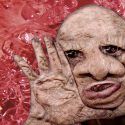Whales are perfectly adapted for life in an aquatic habitat. Their nostrils, or blowholes, are located on the top of their heads. Whales are covered in a thick layer of insulating blubber to keep them warm in the cold water. And instead of fingers, they have flippers for swimming. A blue whale’s tongue weighs as much as an elephant. Its heart is the size of a smart-car. And its blood vessels are so wide that a human could squeeze through them! Instead of teeth, blue whales use baleen to catch their food. The whale sucks in a huge volume of water and shrimp-like krill into its mouth. It then uses its huge tongue to push the water through the hundreds of baleen plates. The krill are trapped and swallowed, and the water is released back into the ocean. The whale will trap and eat up to 40 million krill each day!
How about the sperm whale? This whale is so big that it’s supporting a whole community of animals. Whale lice eat algae growing on the whale’s skin. The barnacles attached to this whale filter food from the passing water. One healthy humpback whale had 450 kg (992 pounds) of barnacles growing on it! The sperm whale is the largest toothed whale. They are master divers, often reaching depths of 606 meters (2,000 feet), and their hunting trips can last over 45 minutes. These carnivores feast on deep-water squid, sharks, and fish.
Dive inside a whale with Cosmo in the episode above!





















